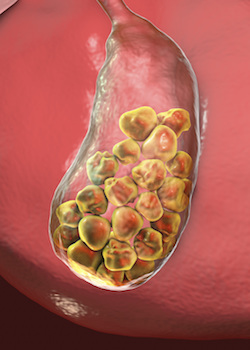Gallbladder Removal / Cholecystectomy Long Island, New York
 Gallbladder removal surgery, known as a cholecystectomy, is one of the most common general surgical procedures in the United States with over 600,000 procedures performed annually. Typically, gallbladder removal is performed because of the formation of painful gallstones in the gallbladder that may migrate into the common bile duct. There is no effective and proven way to eliminate gallstones in a non-surgical manner. While gallstones can affect both genders, women and those over the age of 40 are much more likely to experience a gallstone attack than men and younger patients.
Gallbladder removal surgery, known as a cholecystectomy, is one of the most common general surgical procedures in the United States with over 600,000 procedures performed annually. Typically, gallbladder removal is performed because of the formation of painful gallstones in the gallbladder that may migrate into the common bile duct. There is no effective and proven way to eliminate gallstones in a non-surgical manner. While gallstones can affect both genders, women and those over the age of 40 are much more likely to experience a gallstone attack than men and younger patients.
Laparoscopic gallbladder surgery requires an incision in the navel (through which the laparoscope is passed) and two or three incisions in the upper abdomen. Laparoscopic devices are passed through these incisions. The surgeon will carefully separate the gallbladder from surrounding structures and remove it from the abdomen using a special surgical bag. The procedure requires general anesthesia, is performed on an outpatient basis, and usually takes less than an hour to complete.
Symptoms of Gallstones
The symptoms of gallstones can vary, but generally the patient will feel pain in the upper, right quadrant of the abdomen where the gallbladder is located. A feeling of nausea or vomiting may accompany the pain, which can become severe. Some cases of gallstones can also cause jaundice – the yellowing of the skin and eyes. Gallstones can, of course, irritate the gallbladder, but it can also cause acute pancreatitis. Typically, patients will feel symptoms worsen after a meal, particularly one that is high in fat.
An ultrasound is usually all that is needed to diagnose gallbladder disease, although CT scans, MRIs and a Cholescintigraphy (HIDA Scan) can be used if necessary or recommended by your medical team to identify gallstone location.
When is Gallbladder Surgery Necessary?
Symptomatic gallstones – those that cause painful symptoms known gallstone attacks, are often indicated for surgical treatment. While these attacks may pass, the likelihood is that they will return, often with greater severity each time.
Many patients may live with asymptomatic gallstones for years, and some, their entire lives. Even if the gallstones are incidentally found during an imaging test, treatment may not be needed if no symptoms are present.
Prognosis After Gallbladder Surgery
Gallbladder surgery is a very safe and effective procedure, and most patients will recover from surgery uneventfully and without any lasting changes to their digestion. Recovery is quick and most patients will return to normal activity within a week or two after laparoscopic surgery. Open surgery may require a longer hospital stay and recovery time.
Risks and Considerations of a Cholecystectomy
- Most of our cholecystectomies are performed in a minimally invasive manner, however, some cases may require conversion to open surgery during the procedure. Open surgery is still safe and effective but will require longer recovery time.
- Gallbladder surgery comes with the risks of any laparoscopic surgery, including reaction to anesthesia, infection, bleeding, possible injury to the common bile duct or surrounding organs.
- Gallstones may form in the common bile duct even without a gallbladder.
- A very small number of patients may have some short-term bowel movement issues that will likely resolve in due course.
As with any surgical procedure, risks can be minimized by employing a highly-experienced surgical practice such as ours. For more information about gallbladder surgery, and to schedule a consultation, please contact us.
